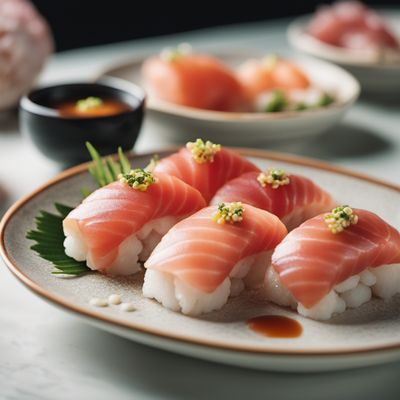
Recipe
Korean-style Katsudon
Crispy Pork Cutlet with Korean Flavors
4.8 out of 5
In Korean cuisine, Katsudon is given a unique twist with the addition of traditional Korean flavors. This Korean-style Katsudon recipe combines the crispy and tender pork cutlet with a savory and slightly spicy sauce, served over a bed of steamed rice. It's a delightful fusion dish that will satisfy your cravings for both Japanese and Korean flavors.
Metadata
Preparation time
30 minutes
Cooking time
15 minutes
Total time
45 minutes
Yields
4 servings
Preparation difficulty
Medium
Suitable for
Omnivore, Gluten-free (use gluten-free soy sauce and breadcrumbs), Dairy-free, Nut-free, Low-fat
Allergens
Wheat (if not using gluten-free soy sauce and breadcrumbs)
Not suitable for
Vegetarian, Vegan, Paleo, Keto, Low-carb
Ingredients
The Korean-style Katsudon differs from the original Japanese version by incorporating Korean flavors into the sauce. The sauce is made with Korean chili paste (gochujang) and soy sauce, giving it a slightly spicy and umami-rich taste. Additionally, the dish is served with a side of kimchi, which adds a tangy and refreshing element to the meal. We alse have the original recipe for Katsudon, so you can check it out.
-
4 pork cutlets (120g each) 4 pork cutlets (120g each)
-
1/2 cup all-purpose flour (60g) 1/2 cup all-purpose flour (60g)
-
2 eggs, beaten 2 eggs, beaten
-
1 cup panko breadcrumbs (100g) 1 cup panko breadcrumbs (100g)
-
Vegetable oil, for frying Vegetable oil, for frying
-
4 cups cooked rice (800g) 4 cups cooked rice (800g)
-
1/4 cup gochujang (Korean chili paste) (60g) 1/4 cup gochujang (Korean chili paste) (60g)
-
2 tablespoons soy sauce (30ml) 2 tablespoons soy sauce (30ml)
-
2 tablespoons sugar (30g) 2 tablespoons sugar (30g)
-
1 tablespoon rice vinegar (15ml) 1 tablespoon rice vinegar (15ml)
-
1 tablespoon sesame oil (15ml) 1 tablespoon sesame oil (15ml)
-
1 onion, thinly sliced 1 onion, thinly sliced
-
4 green onions, chopped 4 green onions, chopped
-
4 tablespoons kimchi, for serving 4 tablespoons kimchi, for serving
Nutrition
- Calories: 550 kcal / 2300 KJ
- Fat: 15g (Saturated Fat: 3g)
- Carbohydrates: 80g (Sugars: 10g)
- Protein: 25g
- Fiber: 4g
- Salt: 2g
Preparation
-
1.Pound the pork cutlets to an even thickness of about 1/2 inch.
-
2.Set up a breading station with three shallow bowls: one with flour, one with beaten eggs, and one with panko breadcrumbs.
-
3.Dredge each pork cutlet in flour, dip it in the beaten eggs, and coat it with panko breadcrumbs, pressing gently to adhere.
-
4.Heat vegetable oil in a large skillet over medium heat. Fry the pork cutlets until golden brown and cooked through, about 3-4 minutes per side. Transfer to a paper towel-lined plate to drain excess oil.
-
5.In a small bowl, whisk together gochujang, soy sauce, sugar, rice vinegar, and sesame oil to make the sauce.
-
6.In the same skillet, sauté the sliced onion until translucent. Add the sauce mixture and simmer for 2-3 minutes until slightly thickened.
-
7.Slice the fried pork cutlets into strips and add them to the skillet. Stir gently to coat the cutlets with the sauce.
-
8.Divide the cooked rice among four bowls. Top each bowl with the pork cutlet strips and sauce.
-
9.Garnish with chopped green onions and serve with a side of kimchi.
Treat your ingredients with care...
- Pork cutlets — Pound the cutlets to an even thickness to ensure they cook evenly and become tender.
- Gochujang — Adjust the amount of gochujang according to your spice preference. Add more for a spicier flavor or reduce for a milder taste.
- Kimchi — Use store-bought kimchi or make your own for a homemade touch. The tangy and spicy kimchi complements the dish perfectly.
Tips & Tricks
- For an extra crispy pork cutlet, double coat the cutlets by dipping them in the beaten eggs and breadcrumbs twice.
- Serve the Korean-style Katsudon with a side of pickled vegetables for added freshness and crunch.
- If you prefer a less spicy sauce, reduce the amount of gochujang and add a bit more soy sauce for a milder flavor.
- Make sure the oil is hot enough before frying the pork cutlets to achieve a crispy and golden crust.
- Leftover Korean-style Katsudon can be stored in the refrigerator for up to 2 days. Reheat gently in a skillet or microwave before serving.
Serving advice
Serve the Korean-style Katsudon hot, straight from the skillet, to enjoy the crispy pork cutlet and flavorful sauce at their best. Garnish with chopped green onions for a pop of color and freshness.
Presentation advice
To enhance the presentation, arrange the sliced pork cutlet strips neatly on top of the rice in each bowl. Drizzle some extra sauce over the cutlets and sprinkle with sesame seeds for an added touch of elegance.
More recipes...
For Katsudon » Browse all
For Japanese cuisine » Browse all
More Japanese cuisine dishes » Browse all

Gyukatsu
Gyukatsu is a Japanese dish that is made by deep-frying breaded beef cutlets. It is a popular dish that is often served at specialty restaurants...

Tsukudani
Tsukudani is a Japanese dish that is made by simmering seafood, meat, or vegetables in soy sauce and sugar. The dish is typically served as a...

Sumi ika nigiri
Squid Nigiri
Sumi ika nigiri is a type of sushi that features a small ball of sushi rice topped with a slice of fresh squid. It is a popular dish in Japan and...
More Korean cuisine dishes » Browse all

Jeon
Jeon is a Korean pancake that is made with a variety of ingredients, such as seafood, vegetables, or meat. It is a popular dish in Korea and is...

Ojingeo chae bokkeum
Spicy Squid Stir-Fry
Ojingeo chae bokkeum is a Korean stir-fry dish that is made with squid and vegetables. It is a popular dish in Korean cuisine.

Dakjuk
Chicken Porridge
Dakjuk is a Korean chicken and rice porridge that is often served as a comfort food during cold weather or when someone is feeling under the...











